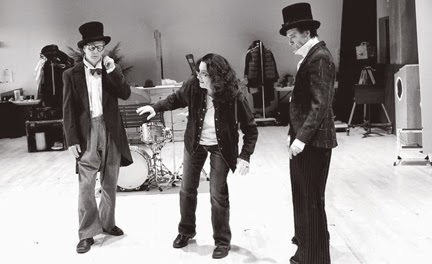A Heavy Dose of Liveness: An Interview with Director Tina Landau
A Heavy Dose of Liveness
An Interview with Director Tina Landau
 |
| Bill Irwin (left), Tina Landau (center), and David Shiner in rehearsal for Signature Theatre's 2013 production of Old Hats, photo by Gregory Constanzo |
Although Old Hats is unlike anything Landau had ever worked on before, she was particularly well-suited to direct this physical show, as she coauthored The Viewpoints Book with Anne Bogart. Viewpoints is a method of theatrical composition that heavily focuses on physicality, movement, and gesture. “I feel very comfortable in Bill and David’s world, because I always think of my theater work in a physical way,” Landau says. “It surpasses the verbal.”
What is it like directing two clowns?
Bill and
David had never worked with an official director on one of their projects
together. I agreed to a one-week workshop, and for the first three or four
days, I went home thinking, “Wow. They’re amazing. I could be a fly on the wall
forever watching them work, but they do not need me in the room.” But I also
very intentionally didn’t go in thinking of “directing” the way I usually do. I
just wanted to observe and see what their process was and see if I thought I
could be helpful. Before I knew it, they started saying, “What do you think
about that? What does that look like?” Very slowly, we realized
that it was a wonderful match and I should continue with the project.
How would you describe a clown’s relationship to the audience, compared to that of
a more traditional actor?
I think ultimately the goal is the same, which is to connect and to engender
feeling, and thereby ask us to take a new look at our own lives or help us find
a moment of solace. The goals of a clown are very similar to the goals of
performers in general, but the means are different: a clown uses primarily
laughter. Clowns are quite clear on the fact that people laugh at misfortune
and failed attempts and mistakes, so they elicit what ends up being a very
joyful evening through moments that are filled with human foible and error and
sadness. There has to be some pain in the comedy. That’s what it is born out
of.
 |
| David Shiner (left) and Bill Irwin in Signature Theatre's 2013 production of Old Hats, photo by Joan Marcus |
When we hear words, a part of our brain engages that only allows us to hear what is
being said, but not necessarily how it’s being said. We glom onto
meaning, and the meaning is very prescribed by how we understand that word. A
picture is worth a thousand words. It leaves the individual audience member
open to access a part of the mind that is more associative than literal.
What was your favorite part of working
on Old Hats?
Often as a director, at some point in previews, I start getting tired or bored or scared
of my own work, and I often find an inability to see it afresh. I never for an
instant feel that with these guys. I could watch them every night of a long run
and know that something is actually happening in this theater tonight that did
not happen last night and won’t happen again tomorrow. That’s the kind of
theater experience I think we all long for: a real, strong, heavy dose of what
I’d call “liveness.”
Landau’s directorial work
includes several shows in New York, including Bells Are Ringing and Tracy Letts’s Superior Donuts on Broadway. Landau is also a company member of Steppenwolf
Theatre in Chicago and has directed numerous shows there. Most recently at
A.C.T., Landau directed The
Time of Your Life,
by William Saroyan, in 2004.
To read more of Tina Landau's experience and to learn more about A.C.T.'s production of Old Hats in our latest edition of Words on Plays click here.

